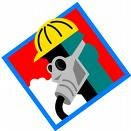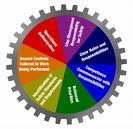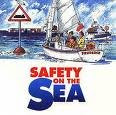Now you've committed yourself to taking the NEBOSH Certificate, you've probably wondered what you've got yourself into! Hopefully the following hints & tips will help you to get the maximum marks possible.
Tips for the Written Papers
First Things First!
Start by reading the exam paper all the way through. You should find at least one question that you are confident about answering. The pages in your answer book are numbered according to the question you are answering, so it doesn't matter in which order you do the questions, as long as you put your answer on the corresponding page of the answer book. It's a good idea to start with the question you're happiest about, as this gets your brain working and gives you confidence. Work through a couple of 'easier' questions & then tackle some of the harder ones. Just make sure you attempt them all!
Clock Watch!
You must keep your eye on the time. You are allowed 2 hours for each paper.. There are 11 questions on each paper, and you are expected to answer every one. Question 1 is worth 20 marks, and you should allocate about 25 minutes for your answer. Questions 2-11 are worth 8 marks each, and therefore you have to answer 10 questions in 90 minutes. If you allow 8 minutes for each question, you will have a small cushion at the end to check over your paper, or to finish any last bits.
Please remember: -
It is better to provide an answer to every question than to do 9 or 10 of them well!
Statistically, candidates score the most marks for the information they give at the beginning of their answers. You will get very few extra marks for a long, rambling answer.. It's also worth remembering that for any question you fail to attempt, your score will be ZERO!
So, answer every question, even if you're not over-confident. If you have reached the time limit (25 minutes for Q1 & 8 minutes for each of the others) MOVE ON! You do not want to end up wasting time perfecting one answer if it means you run out of time to attempt all the questions.
Answer the Question!
We all know the sorts of questions we would like to be on the paper - trouble is, they're not always there! You need to:
· READ THE QUESTION
Get an idea of what the question is asking. This is especially important on Q1, which is often a part question. It is very easy to start rushing in to the answer, only to find when you get to part (ii) that you're writing similar things. NEBOSH do not ask you to give the same information twice in one question, so if this is happening, you're going wrong.
· READ IT AGAIN, BEFORE YOU START WRITING!
This will give you an idea of the depth of answer required, denoted by the action verb (e.g. outline, describe, state, list etc). It also focuses your mind on actually answering. It is a good idea to highlight the important words in the question, either by underlining them or by using a highlighter pen. Again, this clarifies what you are being asked and allows you to think about what your answer should be. You can’t take your exam paper away with you, but you can highlight things on it.
· Once you've started your answer, check the question to make sure you're answering what you've been asked.
If I had £1 for every student who'd gone off at a tangent in their answer to a NEBOSH question, I'd be a very rich lady!! You will do this at some point, but it's a good idea to make sure it happens in the classroom rather than in the exam! Simply by checking that you are answering the question, whilst you are doing it can save an awful lot of time & heartache. If you check halfway through, it does give you time to salvage something if you've gone wrong. (I’ve done it!).
Question Spotting!
NEBOSH are well aware that students practice answering past questions, and although they do repeat questions, they may not be straight repeats. You may see part of a question that has appeared before, with a different second part. Just be aware that you must read the question thoroughly and keep checking that you’re answering the right question.
Specific Types of Question
Some types of question come up again & again. On the Management paper you are often asked to "Outline the factors to consider when……..". This type of question requires you to think about the situation you have been given, and take an overview. They do not usually ask you to fix it! i.e. you do not have to outline a series of control measures. This is a very common mistake in approaching this type of question.
E.g. If you were asked to outline the factors to consider before forklift trucks are to be introduced to a new warehouse, you would outline factors such as
· The need for separating FLT movements from pedestrians;
· The need for the introduction of speed limits;
· Whether high visibility clothing would be required;
· The condition of the floors and terrain
· The type of FLT to be introduced e.g. the appropriate fuel supply
· The loads to be carried etc.
You should turn this list into an outline by adding the reason for each consideration you mention e.g. The condition of the floors and terrain would be an important consideration, as floors containing potholes or steep slopes can result in overturning of fork lift trucks.
It is tempting to try to fix the situation by giving answers such as: -
When FLTs are to be introduced into the workplace, it is essential that they do not come in to contact with pedestrians. In order to prevent this, dedicated traffic routes should be introduced, with speed limits. Any pedestrians who enter the area in which the FLTs are moving should wear appropriate PPE, such as high-visibility vests. In a warehouse, you should make sure that if the ventilation is poor, the FLTs are battery-powered. The floors should be free from potholes, as this can cause overturning of the FLT……………
These are in fact control measures to reduce the risks from FLTs operating in a new warehouse - but that's not actually what the question asked you for!! If you start doing this, you will get carried away & start answering a different question from the one you’ve been asked – don’t do it!
If you have trouble interpreting "Outline the factors to consider”, substitute “things” for “factors” & it might make the question easier to understand.
Hazards paper questions are usually a bit more straightforward, requiring either hazard identification or control measures or both.
Make sure that you understand the difference between hazard & risk. Some questions may ask you to identify hazards & others will ask for risks. If you get these mixed up, you may not get the marks. Remember that risks are outcomes.
Your answers
There are some basic rules to follow:-
Answer the question you’ve been set!
Don’t write a list if you’re asked for an outline (unless you’re running out of time) – you will loose marks.
If you include training, instruction or information as an answer, say what sort of training, information or instruction is required.
PPE is not sufficient as an answer, even in a list – give some examples of suitable PPE.
Answer the question you’ve been set!
If you’re asked for a list, single words are unlikely to score you marks. It’s not a shopping list - you need enough details to make the examiner understand what your point is.
Use principles to keep you organised. E.g. if you’re asked for controls, work through the Hierarchy of control giving appropriate examples; if you’re asked how you would manage a situation – apply the principles of HSG65 etc.
Answer the question you’ve been set!
Always remember, although Examiners are intelligent, they don’t know you – you have to get your answer down on paper in a way that tells them exactly what you mean.
When you've finished!
You should have a few minutes spare to check through your answers. Yes, I know it's boring, but you may think of something you couldn’t answer earlier, see part of a question you’ve forgotten to answer or see a glaring error. It's easier to pick up the odd extra mark by filling in gaps in questions which require you to list or identify, so if you've missed any out, now's the time to check what you've written and see if you've missed anything obvious.
FAQs
What if I'm running out of time?
If you find yourself with only minutes to spare to the end of the exam, & you still have a question to do, complete it as a list. This at least gives you the chance to get some marks, rather than leaving it blank and scoring zero. The extra marks you pick up here could make the difference between referral/ pass; pass/credit, or even credit/distinction! If you do have some time spare on an outline, describe or explain question, add a reason or an example – it may get you full marks.
How can I improve my chances of passing?
· Revise as you go - you cannot leave it until the last minute, as there is far too much information to take in. Also you need to ensure that you understand what you've been taught/have read. If you are having problems, you will be able to clarify them with your tutor in plenty of time.
· Practice past questions - You can obtain past question papers and Examiners' Reports from the NEBOSH website
http://www.nebosh.org/. You should aim to practise answering questions and then check your answer against the Examiners' comments. There are often repeated questions on exams, so having practised a good selection may help with any repeated questions on your exam.
· Don't panic! - Panic will just make it harder to answer the questions. It can be tempting when you read the exam paper to panic if you think you can't do some of the questions. Just breathe deeply, read the question paper again & start with a question you are reasonably happy with.
Tips for the Practical
The Inspection
Get organised! Think of the areas that you need to look at. Put those headings on individual sheets at the start of the exam. There’s no restriction on the number of sheets you use.
Make sure you fill in each column of the observation sheet – don’t leave the risk level or the action required columns blank, as it will reduce your marks.
Don’t mark everything as high risk which needs action immediately – your suggested corrective action needs to be achievable as well as aimed at reducing the risks.
Aim to give a spread of actions to correct problems where possible. Single actions often don’t prevent the problem from recurring, and may need considerable budget. Suggest some intermediate steps to reduce risk progressively with sensible timescales. Ongoing monitoring also signifies that some solutions need checking to maintain their effectiveness.
The Report to Management
This needs to be concise, convincing and it needs to address URGENT issues. Your time is short, so the report also needs to be short.
Use headings and give it a structure. A summary will aid readability and will persuade (or not!) the manager to read the full report.
Pick no more than 5 urgent issues and make sure that for each one, you say:-
What you found (in general terms)
Why it's a problem (what the possible outcomes are)
What legislation is being breached (e.g. contravenes the COSHH Regulations)
What needs to be done (include any statutory requirements e.g. Requirement of Fire legislation that all premises have an emergency plan)
Who needs to do it (e.g. workshop manager)
Timescale (e.g. should be carried out within the next week). Don't forget to include longer-term action where appropriate.
An indication of cost (low, medium, high)
Remember that in general you are asking management to part with money, so you need to convince them that they should! State the likely benefits of implementing your suggested actions e.g. reduces the risk of serious injury to students and the likelihood of enforcement action and civil claims.
Remember to include both breeches of legislation and costs – these are commonly forgotten and there are a total of 10 marks available for them.
GOOD LUCK!
HAVE A SAFE AND PROSPEROUS DAYT.






















